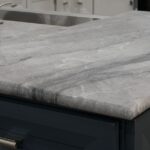Granite is the classic stone for a countertop. It’s hard, strong, and durable, having many possible applications while not needing too much maintenance. However, if you’re interested in getting a granite countertop, you should also learn about engineered granite.
Even though engineered granite is a great material to use, it’s not very well known. Natural granite is already a classic, the go-to option for a countertop. However, being aware of your options is a great way to get the best deals and to figure out what could work better for you.
So, in this article we’ll talk about engineered granite and how it could be a good option for you.
Do you want to know more about natural granite? Then be sure to check out our definitive guide on granite countertops! We gathered together all of the most important information on this awesome stone so you can make a more informed decision on your next countertop.
What Is Engineered Granite?
Engineered granite is a kind of engineered stone, meaning it’s not a natural stone.
Natural stone slabs are slabs made from natural, unchanged stone. People extract the stone from a quarry, cut it into the desired dimensions, seal it (to prevent stains and other kinds of damage), then put it to use.
It may seem weird to think that natural granite is a single stone. Many granite types have many different colors, which look like a bunch of little stones glued together. However, the different minerals that compose granite were fused together by the pressure of all the rocks above it, which also made the stone become very strong.
Engineered stone, on the other hand, is made a bit differently. As the name shows, it was “engineered”, that is, it was man-made. Instead of being the full natural stone, engineered stone consists of an agglomeration of stone particles, joined to together by a special resin.
That can seem a bit weird. The resin is, of course, much softer and less resistant than stone, so that could cause problems, right?
Not really. Engineered stones are normally about 95% stone and 5% resin. The resin added is just enough to keep the particles joined together. And this doesn’t really cause problems, unless you manage to reach temperatures that could liquefy the resin. But those are some very high temperatures, so you don’t need to worry too much about it.
That engineered process doesn’t even damage the stone’s resistance. Engineered quartz, which is one of the most common engineered stones, is about as resistant as quartzite, its natural counterpart.
Engineered stone is able to give you most of the advantages of natural stone, while also generally costing a bit less.
Natural Or Engineered Granite?
The main advantage that engineered granite has over natural granite is lack of porosity, but it’s also more resistant to chipping and cracking.
Porosity
Every natural stone is naturally porous in some way. Granite is not as porous as marble, for example, but it still is. The main problem with porosity is that it makes staining it much easier. Liquids that have strong colors, like wine and coffee, can get into the pores, dry out, and leave their pigments there. Taking the stains out then takes some work.
To try to avoid this, natural stones are normally sealed. Sealing consists on applying a layer of some waterproof material, like natural wax or some kind of plastic. This really helps to make the stone more resistant to staining, while also making it smoother and shinier.
However, the stain is much less resistant than the stone, and regular use will make it wear off over time. So, after a while, stains will start to appear on stone. In order to fix this, you’ll have to remove the stain and reseal the stone.
Engineered granite doesn’t have this problem. By saturating the stone with resin a very resistant resin, you fill up all the pores. This way, it’s much more resistant to staining, and you also don’t need to stain it again from time to time.
Chipping And Cracking
While natural stones can be very resistant, they also aren’t perfect. With regular use, they start to get damaged. This is true of any material, but the stone’s porosity can make it wear off quicker, as the liquids that get into it can weaken the bonds between the minerals and cause unwanted chemical reactions.
Over time, cracks may start to appear, and the stone may start to chip. The corners are the parts which tend to break first, so it’s important to be extra careful with them.
Engineered stone, on the other hand, is much less prone to cracking and chipping, thanks to its much lower porosity. Not only that, but it’s more resistant to cutting too, meaning you could cut food directly on top of it. Using a cutting board is still recommended in order to maximize its durability and maintain its appearance, but it’s a notable feature it has.
What’s The Catch?
Of course, nothing is perfect, and natural granite does have advantages over engineered granite.
The first is, of course, bragging rights. While engineered granite is much better in terms of usability, it’s a bit frowned upon and perceived as a “cheap” alternative. It does tend to cost a bit less, but that just increases its cost-benefit. Still, natural granite can help increase the value of your home.
Engineered granite also tends to have a slightly shorter lifespan than natural granite.
That may sound a bit strange, as in the last section we talked about how granite tends to crack and chip more easily. The thing is, just having cracks and chips doesn’t mean something can’t last a long time. It depends on what you’re using it for. If you’re making your countertop carry some heavy weight all the time, then it’s more likely to break. Otherwise, it can still hold up for a long while.
The matter with engineered stone is that the resin is not nearly as durable as the stone itself. Over time, it starts to lose its strength. The main culprit is heat: being a kind of plastic, heat can slowly make it deteriorate, making the stone particles loosen up and start to fall off.
Because of this, it’s not a good idea to use engineered granite in places that can get too hot. Placing it outside, for example, is a bad idea, especially if sunlight can hit it directly.
Having Trouble Deciding?
Choosing the best stone for a countertop can be very hard, as different places in a house can have very different needs. There are also many different kinds of stone to choose from, and each one comes with their advantages and disadvantages.
If you’re unsure on what kind of stone to use in your home, be sure to contact us! We specialize in stone for countertops, especially granite and marble, and can send a specialist to your house to figure out what would be the best choice for you.



